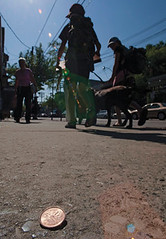
PREV ARTICLE
NEXT ARTICLE
FULL ISSUE
PREV FULL ISSUE
MCLEANS PUBLISHES A TRIBUTE TO THE CANADIAN CENT
Dick Johnson submitted the following note on an article from Canada about the cent.
-Editor
The article is not what is usually encountered by non-numismatic writers. The author did a superb job in this report. It should also be preserved in every numismatic library for every collector of this country's coins for all time to come.
Here are some excerpts.
-Editor
Coppers, as they were called, remained for years a phenomenon of Canada's East—unpopular beyond Ontario and an early emblem of western distaste for Toronto, Ottawa, Montreal. "You left Ontario, the coppers became worthless," says Ian Laing, president of Winnipeg-based Gatewest Coin Ltd. "People gave them away as they left." Attitudes toward the cent were still antagonistic as late as 1905, when Jack and Timothy Eaton opened a five-storey Eaton's in Winnipeg, where retailers had banded together to keep the penny out by pricing goods to the nickel. When Jack, a stickler for such things, decreed his prices on Portage Avenue would be the same as in Toronto, he sent $500 worth of one-cent coins to Winnipeg. Beside each cash register, he set up charity boxes so customers could discard them should they wish. But he began to sell newspapers at two cents rather than five. Soon, all of Western Canada was awash in pennies. It's easy to forget the Canadian one-cent coin, modelled after the decimalized, very practical U.S. penny (introduced in 1793), once represented an improvement—and not just over the maddening abacus of British denominations, with all those 240 pence required to count out a pound. In 17th-century Newfoundland dried cod was used as currency—likely so that poor Newfoundlanders might emulate the stinking rich. Moose hides and gold dust, molasses and wheat have all at one place or another been used as money in Canada. So have Portuguese escudos, old French livres, Dutch guilders, U.S. pennies stamped with a long-haired Liberty, and Spanish dollars, often cut into eight bits to make change (hence the expressions, "two bits," meaning a quarter, and the "pieces of eight" of pirate lore). Brass coat buttons, de-shanked, flattened and stamped, were enlisted as currency, and an archaeological dig in Quebec unearthed an ancient Greek bronze as part of an early settler's pocket change. "It just shows you money always has some value to somebody," says Paul Berry, chief curator of the National Currency Collection, part of the Currency Museum at the Bank of Canada.
If you are interested in Canadian coins, don't waste a moment in reading this article:
A penny dropped
(www2.macleans.ca/2011/01/14/a-penny-dropped/)
The Numismatic Bibliomania Society is a non-profit organization promoting numismatic literature. See our web site at coinbooks.org. To submit items for publication in The E-Sylum, write to the Editor at this address: whomren@gmail.com To subscribe go to: https://my.binhost.com/lists/listinfo/esylum All Rights Reserved. NBS Home Page Contact the NBS webmaster 
|
